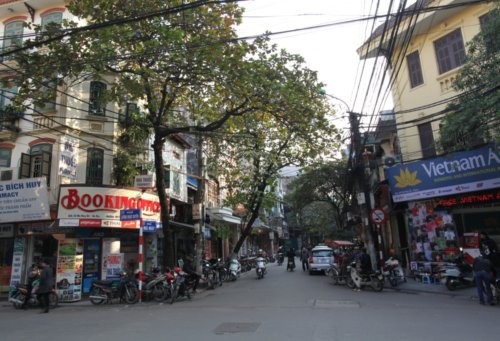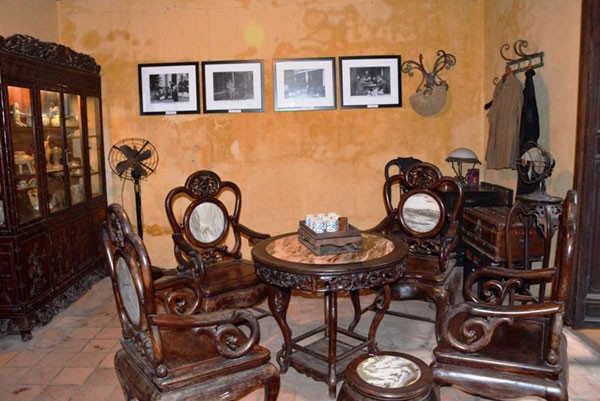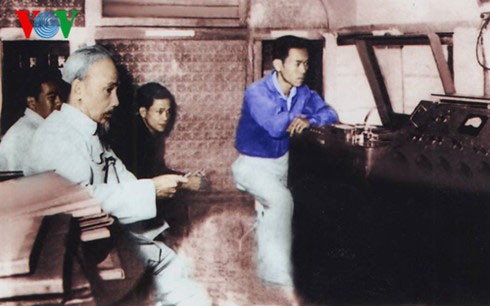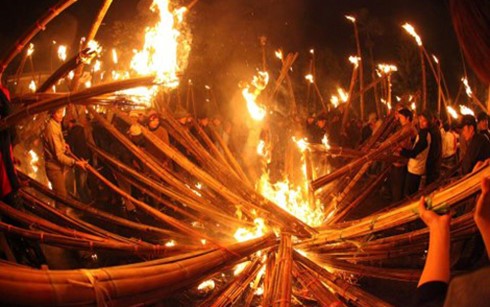(VOVworld) – Tet, Vietnam’s Lunar New Year festival, is the biggest festival of the Vietnamese people and its core element is the family reunion. Tet, a time spent with loved ones, leaves vivid memories because people wait for it all year with growing excitement. In this week’s edition of That’s Life, we will compare some foreigners’ views of Tet with some Vietnamese people’s memories of Tet.
 |
| The crossroad at Luong Ngoc Quyen and Ma May street (Photo: 360.hncity.org) |
Tet seems to go by in the blink of an eye and then life is back to its normal pace. Restaurants are open. Streets are crowded. And the sun is shining as if summer is just a few days away.
I’m wandering around the Old Quarter, savoring the last moments of Tet and my days off work. I take a bite of “banh ran”, a type Vietnamese donut, I’ve just bought in Luong Ngoc Quyen street. Mmm! The sweet, hot donut with fragrant sesame really lifts my mood. I walk leisurely down Ma May street, heading to Sword Lake. On the way, I drop in at an ancient house at No.87 whose quiet, nostalgic atmosphere makes me feel Tet is still here. There I find an exhibit of black-and-white photos of Tet celebrations in the early 1990s when people still wore the traditional “ao dai” and drove the large tricycles called “xich lo”.
 |
Photos of Tet celebrations are hung on walls of the ancient house at 87 Ma May street.
(Photo: thanglong.chinhphu.vn) |
There I meet 2 American tourists. "Peaceful, very traditional. I can see a lot of love". "I would say traditional". That is the reaction of Doug and Julia Deming to the photos. They both have the same favorite photo of a family get-together and grandparents offering their grandchildren “li xi”-lucky money. Doug Deming said: "The one with the grandfather and grandchildren. It’s the most impressive photo to me ‘cause it shows children respecting their grandparents and the family bond is precious. The family bond is very important in the US and the children honor their grandparents in the same way as here: they respect and love their grandparents". Julia Deming said: "I like the same picture. I thought it was really cute. Children honoring their grandfather is very nice. It’s very similar with what we have at home".
For Vietnamese people, reunion is the core value of Tet. People who live far from home try to return before Tet and those who cannot return feel very sad because they miss their loved ones. Vu Van Tuc, an old man visiting exhibit who has the same favorite photo as the 2 Americans, agrees. Tuc shared with us this story while he was a soldier: "Even on the battle field, we still celebrated Tet and offered Tet wishes to fellow comrades. We cried a lot during Tet because we really missed home but couldn’t return. We re-read letters sent from home again and again until the letters were falling apart. It was really touching. We told stories about every family member. We even assigned whose stories would be told on each specific day so that we never ran out of stories".
The war was brutal. If a soldier revealed his position, the whole battalion might be killed. So Tet celebrations of Vietnamese troops were done in secret: living without a trace, cooking with no smoke, and talking in whispers. But that didn’t keep them from enjoying Tet among their comrades-in-arms. Nguyen Duy Bao, a former military pilot, told us: "Soldiers cleverly dig holes in the shape of trays, plates, and bowls. We used a large plastic sheet to cover the holes and put food into them. We often sheltered in the forest and from tree branches made chopsticks. The feasts were incredibly simple but we enjoyed them and felt warm".
For all the soldiers who had to endure the extremely difficult conditions of wartime, Tet was a great morale booster. Tuc explains: "I spent more than 10 Tets on the battlefield. What we most anticipated when Tet came was hearing President Ho Chi Minh’s verses on the radio. His poems reflected every soldier‘s determination. Every time we heard his voice, we all believed we would survive, defeat our enemies, and return to our loved ones".
 |
| President Ho Chi Minh read Tet verses on the radio. (Photo: VOV) |
Luckily, Tuc was able to return home after the nation’s victory. What he remembers most about Tet in wartime is President Ho Chi Minh’s poems and in peacetime is the time to gather with neighbors and family. He said: "When I lived in my hometown in Nam Dinh province, minutes before New Year, there was a welcoming ritual at the communal house. All the villagers gathered there for the ritual and then took fire from the communal house to light incense at home. It’s been so long since I did that. During Tet, I loved the family reunion and giving “li xi” to the children. I prepared the lucky money in advance by rubbing it on the pillars at Yen Tu pagoda which I visited during the year. Now I’m too old to do that".
 |
People in Nam Dinh province use their wooden sticks to take fire from the communal house.
(Photo: VOV) |
Vu Kim Thuy, who lives in Hanoi, is most nostalgic about the time she and her 2 younger brothers made Chung cakes while her mother was busy at work before Tet and her father was on the battlefield. She recalled: "When I was in grade 6, my brother and I made Chung cakes for the whole family. It was the subsidy period when we had to wake up at 2 in the morning to queue up to buy sticky rice, “dong” leaves, wood, and green bean. I wrapped the cakes and my brothers boiled them. We sat around the fire and roasted potatoes and corn and ate them while waiting for the Chung cakes. Now it’s easy to buy Chung cakes but I miss the fun of being together when we had Chung cakes dangling from the clothesline in the front yard".
 |
| Hanoians queued up to buy Tet necessities in the subsidy period. (Photo: archive photo) |
Tet has changed over the years, but it’s still about family reunion, a fact the Vietnamese people will always respect.